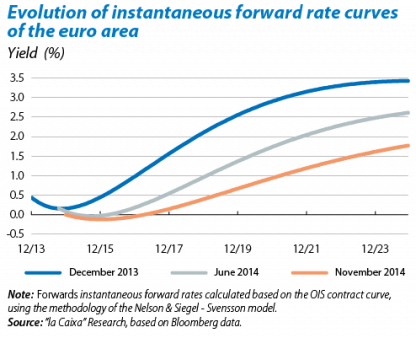The Fed and the ECB are going their separate ways, how long will they take to meet up again?
For some months now the monetary policies of the Federal Reserve (Fed) and the ECB have gradually diverged: the former is slowly moving towards the withdrawal of stimuli and the latter is attempting to implement even more. Ruling out any big surprises, 2015 will witness a milestone in this long goodbye: the Fed will start to raise its official interest rates while the ECB will attempt to keep theirs as low as possible. For obvious reasons, it is less certain just how far these two paths will diverge over time. An analysis of the risk-free asset interest rate curves in the US and the euro area throws some light onto this question.
Put simply, each of these curves is based on the (annualised) returns at different maturities observed at any particular point in time for financial assets whose default is considered to be very unlikely. Starting with the euro area, these assets may be, for instance, German government bonds or swaps on the one-day interbank rate, known as the EONIA. This curve can be used to estimate the expectations of lenders and borrowers regarding the future trend in interest rates. By way of example, if we have the yield on German six and eighteen month bonds, we can deduce the return expected by the market from a one-year bond within six months. This is known as the implied forward rate, which provides a good estimate of the expected interest rate.1
One very useful implied forward rate is the instantaneous forward (which should be seen as an extremely short-term implied forward rate, for example one day) obtained from the EONIA swaps curve. The reason is that it helps to estimate the market's expectations regarding the ECB's official interest rates (the refi rate and the deposit facility rate). The figures observed are extremely revealing: at mid-November this year, the instantaneous forward curve suggests that the ECB's official interest rates will not start to rise until the end of 2017, and that in 2024 (in 10 years' time!) they will still be below 2.0%. Expectation of such a slow interest rate rise reveals the dramatic change in expectations that has taken place over the last few months due to disappointing economic figures and the expansionary announcements made by the ECB. By contrast, in December 2013 expectations had pointed to interest rate hikes starting at the end of 2015 and reaching 2% around 2018. This «lower for longer» scenario of the ECB differs from expectations regarding the Fed's actions. In this case the same instantaneous forward curve for the interbank rate anticipates an upward trend that may be slow compared with previous monetary cycles in the US but is fast compared with what is expected for the ECB. Specifically, the Fed's official interest rate would start to rise mid-2015 and would go above 2% by mid-2017. In fact, the spread between interest rates on both sides of the Atlantic will continue to widen up to 2019, when it will exceed 230 basis points (a level similar to the peaks seen in past episodes).
In short, interest rate curves currently project a scenario of prolonged divergence between the monetary policies of the US and euro area. The «singularity» lies in the extreme slowness expected for interest rate rises in the euro area. But if the recovery in Europe's economy is actually faster than currently predicted by the market, something we believe to be highly likely, then the rate of monetary policy normalisation by the ECB will not be so parsimonious and the paths taken by the two central banks will not take so long to come together again, or at least get closer.
1. A more accurate measurement of expectations would require the risk premium of long-term investments compared with short-term (term premium) to be taken into account. In this Focus, we are concentrating on the results obtained based on the implied forward rate. For more information on the term premium, see «US Treasury term premiums: not yet, but likely» in this Report.

